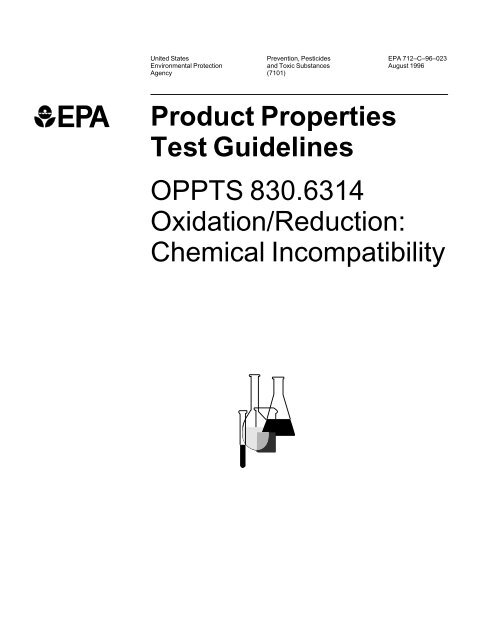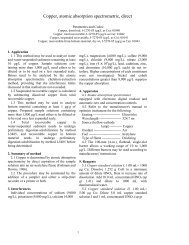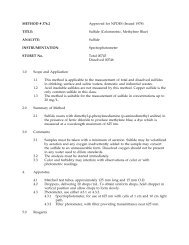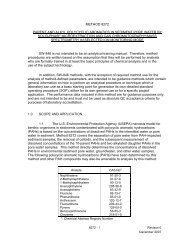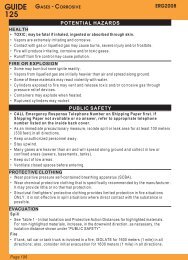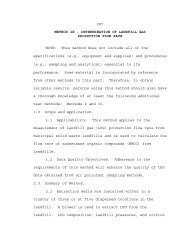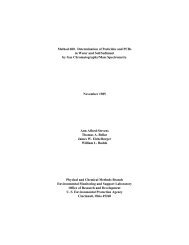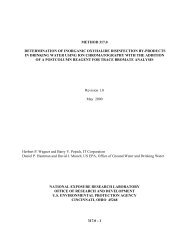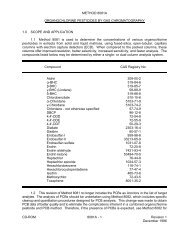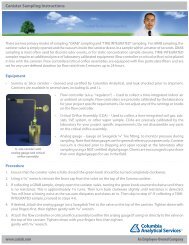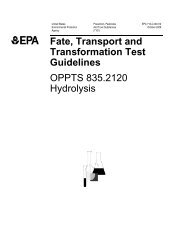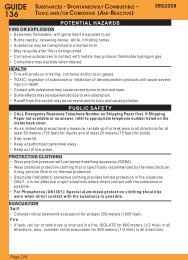View Actual EPA Method 830.6314
View Actual EPA Method 830.6314
View Actual EPA Method 830.6314
You also want an ePaper? Increase the reach of your titles
YUMPU automatically turns print PDFs into web optimized ePapers that Google loves.
United StatesEnvironmental ProtectionAgencyPrevention, Pesticidesand Toxic Substances(7101)<strong>EPA</strong> 712–C–96–023August 1996Product PropertiesTest GuidelinesOPPTS <strong>830.6314</strong>Oxidation/Reduction:Chemical Incompatibility
INTRODUCTIONThis guideline is one of a series of test guidelines that have beendeveloped by the Office of Prevention, Pesticides and Toxic Substances,United States Environmental Protection Agency for use in the testing ofpesticides and toxic substances, and the development of test data that mustbe submitted to the Agency for review under Federal regulations.The Office of Prevention, Pesticides and Toxic Substances (OPPTS)has developed this guideline through a process of harmonization thatblended the testing guidance and requirements that existed in the Officeof Pollution Prevention and Toxics (OPPT) and appeared in Title 40,Chapter I, Subchapter R of the Code of Federal Regulations (CFR), theOffice of Pesticide Programs (OPP) which appeared in publications of theNational Technical Information Service (NTIS) and the guidelines publishedby the Organization for Economic Cooperation and Development(OECD).The purpose of harmonizing these guidelines into a single set ofOPPTS guidelines is to minimize variations among the testing proceduresthat must be performed to meet the data requirements of the U. S. EnvironmentalProtection Agency under the Toxic Substances Control Act (15U.S.C. 2601) and the Federal Insecticide, Fungicide and Rodenticide Act(7 U.S.C. 136, et seq.).Final Guideline Release: This document is available from the U.S.Government Printing Office, Washington, DC 20402 on The Federal BulletinBoard. By modem dial 202–512–1387, telnet and ftp:fedbbs.access.gpo.gov (IP 162.140.64.19), internet: http://fedbbs.access.gpo.gov, or call 202–512–0132 for disks or paper copies.This guideline is available in ASCII and PDF (portable document format)from the <strong>EPA</strong> Public Access Gopher (gopher.epa.gov) under the heading‘‘Environmental Test <strong>Method</strong>s and Guidelines.’’i
OPPTS <strong>830.6314</strong>Oxidation/reduction: Chemical incompatibility.(a) Scope—(1) Applicability. This guideline is intended to meet testingrequirements of the Federal Insecticide, Fungicide, and RodenticideAct (FIFRA) (7 U.S.C. 136, et seq.).(2) Background. The source material used in developing this harmonizedOPPTS test guideline is OPP guideline 63–14 Oxidizing or reducingaction (Pesticide Assessment Guidelines, Subdivision D: ProductChemistry, <strong>EPA</strong> Report 540/9–82–018, October 1982) and 40 CFR158.190 Physical and chemical characteristics.(b) Test method—(1) Objectives. (i) Chemical incompatibility determinesthe likelihood of violent reactions occurring when the new chemicalis mixed or comes into contact with other substances. Thus, dangerouscontact during its chemical life (manufacturing, processing, distribution,storage, use, and disposal) can be avoided. Significant temperature increases,evolution of gases, noxious fumes, splattering, and evolution offlame are possible dangers. As used here, ‘‘significant temperature increases’’is defined as an increase of 5 °C or more.(ii) These tests will indicate hazardous reactions which can occur resultingfrom contact of the chemical with common oxidizing and reducingagents, common fire extinguishing agents, and common solvents.(2) Test details. (i) Information on the oxidation or reduction potentialof a product may be obtained through a knowledge of the chemistryof the product and/or by application of the method described in 44 FR16267 (1979) (see paragraph (d)(1) of this guideline) which is presented,with minor changes, in paragraph (b)(2)(ii) of this guideline.(ii) This qualitative assessment will vary from chemical to chemicaldepending on physical state and intended uses. Subjective judgements bya chemist familiar with the chemical and its intended uses are needed toselect appropriate protocols. The following is only an example of an appropriateset of tests for a hypothetical chemical. All temperature increasesof greater than 5 °C should be noted. Tests should be conducted at temperaturesexpected during the normal use of the chemical. Generally, theratio of the mass of the new chemical to the mass of the chosen reactantshould be high, simulating maximum exposure situations.(A) The chemical should be placed in contact with water for 24 hoursand visual observations recorded.(B) The chemical should be placed in contact with carbon dioxideand/or monoammonium phosphate for 24 hours and visual observationsrecorded. Both of these compounds are widely used fire extinguishingagents.1
(C) For reducing agents, the chemical should be placed in contactwith powdered zinc or iron for 24 hours and observations recorded. Elementalzinc and iron are both moderately strong reducing agents. Datafrom corrosion tests or stability to metals may be suitable in lieu of thistest.(D) For oxidizing agents, the chemical should be placed in contactwith a moderately strong oxidizing agent, one which the chemical maycontact in its intended use. The electrochemical series may be used asa guide (the Handbook of Chemistry and Physics, for example, providesinformation on suitable agents, see paragraph (d)(2) of this guideline).(E) If the chemical is intended for use in households it should beplaced in contact with a household organic solvent, such as kerosene, turpentine,or gasoline, for 24 hours and observations recorded.(iii) If an alternative method is used, it is recommended that the registrantconsult with the agency prior to adopting the test method.(c) Reporting. (1) Descriptions and results of all tests should be provided.(2) Any methods used to characterize the physical properties of apesticide shall be referenced or described in the application for registration.If the methods used are listed in paragraph (d) of this guideline, referenceto the method will suffice. If other methods are used, copies of such methodsmust be submitted with the application.(3) The applicant shall submit his own statistical evaluation of theprecision and accuracy of these measurements (e.g., standard deviationsor confidence intervals) when appropriate.(d) References. The following references should be consulted for additionalbackground material on this test guideline.(1) <strong>EPA</strong>, ‘‘Chemical Incompatibility,’’ FEDERAL REGISTER, 44 FR16267 (1979).(2) Handbook of Chemistry and Physics, CRC Publishing Co., BocaRaton, FL, latest edition.2


